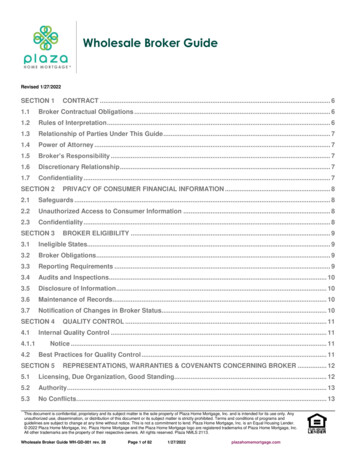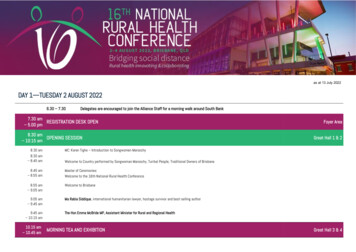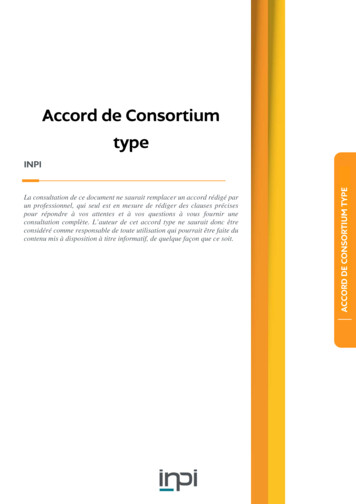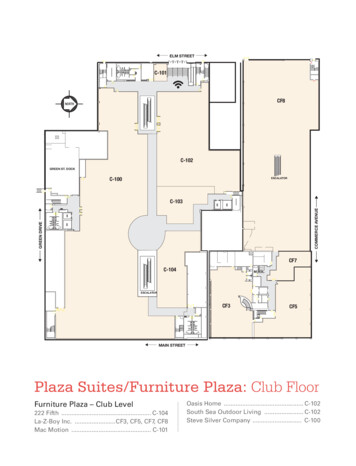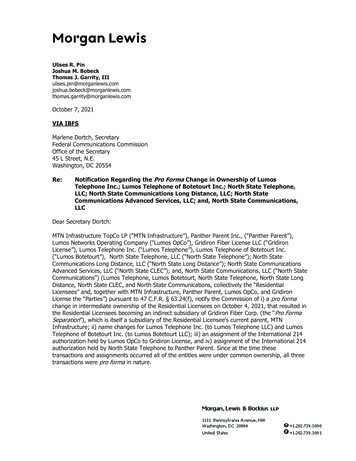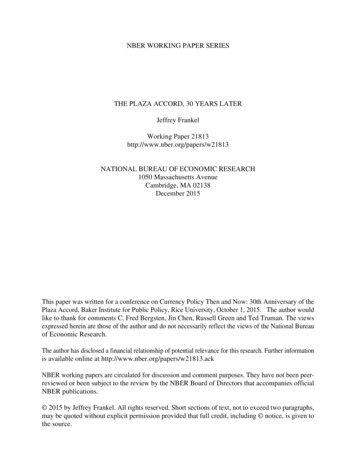
Transcription
NBER WORKING PAPER SERIESTHE PLAZA ACCORD, 30 YEARS LATERJeffrey FrankelWorking Paper 21813http://www.nber.org/papers/w21813NATIONAL BUREAU OF ECONOMIC RESEARCH1050 Massachusetts AvenueCambridge, MA 02138December 2015This paper was written for a conference on Currency Policy Then and Now: 30th Anniversary of thePlaza Accord, Baker Institute for Public Policy, Rice University, October 1, 2015. The author wouldlike to thank for comments C. Fred Bergsten, Jin Chen, Russell Green and Ted Truman. The viewsexpressed herein are those of the author and do not necessarily reflect the views of the National Bureauof Economic Research.The author has disclosed a financial relationship of potential relevance for this research. Further informationis available online at http://www.nber.org/papers/w21813.ackNBER working papers are circulated for discussion and comment purposes. They have not been peerreviewed or been subject to the review by the NBER Board of Directors that accompanies officialNBER publications. 2015 by Jeffrey Frankel. All rights reserved. Short sections of text, not to exceed two paragraphs,may be quoted without explicit permission provided that full credit, including notice, is given tothe source.
The Plaza Accord, 30 Years LaterJeffrey FrankelNBER Working Paper No. 21813December 2015JEL No. F33,F42,N1ABSTRACTThe paper reviews an event of 30 years ago from the perspective of today: a successful G-5 initiativeto reverse what had been an overvalued dollar. The “Plaza Accord” is best viewed not as the preciseproduct of the meeting on September 22, 1985, but as shorthand for a historic change in US policythat began when James Baker became Treasury Secretary in January of that year. The change hadthe desired effect, bringing down the dollar and reducing the trade deficit. In recent years concertedforeign exchange intervention, of the sort undertaken by the G-7 in 1985 and periodically over thesubsequent decade, has died out. Indeed the G-7 in 2013, fearing “currency manipulation,” specificallyagreed to refrain from intervention in a sort of “anti-Plaza accord.” But some day coordinated foreignexchange intervention will return.Jeffrey FrankelHarvard Kennedy SchoolHarvard University79 JFK StreetCambridge, MA 02138and NBERjeffrey frankel@harvard.edu
The Plaza Accord, 30 Years LaterSeptember 2015 marks the 30th anniversary of the Plaza Accord. It was probably the mostdramatic policy initiative in the dollar foreign exchange market since Richard Nixon originallyfloated the currency in 1973. At the Plaza Hotel in New York on September 22, 1985, USofficials and their counterparts among the Group of Five largest industrialized countries agreedto act to bring down the value of the dollar. Public statements from the officials were backedup by foreign exchange intervention, selling dollars in exchange for other currencies in theforeign exchange market.The Plaza is justly celebrated as a high-water mark of international policy coordination. Thevalue of the dollar had climbed 44 per cent against other major currencies in the five yearsleading up to 1985.1 (See Figure 1.) Largely as a result of the strong dollar and lost pricecompetitiveness, the US trade balance had fallen to record lows as of 1985, a deficit of 122billion. The trade deficit spurred congressional support for proposed trade interventions thatan economist would have found damaging.In the two years 1985-87, the dollar came back down 40 per cent. After the exchange rateturned around, so did the trade balance (with the usual lag). In the end, the US Congressrefrained from enacting protectionist trade barriers.The Plaza Accord made institutional history as well. The group of officials that had met in NewYork developed into the G-7 Finance Ministers group, which has continued to meet ever since. 2While the Plaza Accord is generally viewed as having been a major public success, it is soberingto realize that the essence of the initiative -- a deliberate effort to depreciate a major currency - would be anathema today. In recent years, policy actions by a central bank that have theeffect of keeping the value of its currency lower than it would otherwise be are likely to becalled “currency manipulation” and to be considered an aggressive assault in the “currencywars.“ In light of the currency war concerns, the G-7 has refrained from foreign exchangeintervention in recent years. The G-7 partners in February 2013 even accepted a proposal bythe US Treasury to agree to refrain from unilateral foreign exchange intervention, in aninsufficiently discussed ministers’ agreement that we could call the “anti-Plaza” accord.31In log terms. The Fed index of the dollar against major currencies rose from 93 in September 1980 to144 at the February 1985 peak (1973 100).2In 1986, Secretary Baker persuaded the G-7 to agree to monitor a set of “objective indicators,”including GDP and other economic variables, hoping to coordinate economic expansion. In February1987, the G-7 ministers agreed at the Louvre that the dollar had fallen far enough, especially against theyen, and that they would try to prevent it from falling further. Funabashi (1988), Baker (2006, 431-32).3G7 (2013).2
Part 1 of this paper reviews what actually happened at the Plaza in September 1985 andduring the months leading up to it. 4 Parts 2 and 3 of the paper consider the effects of foreignexchange intervention and then the current worries regarding currency manipulation andcurrency wars. Part 4 concludes with a consideration of intervention policy and the dollar as of2015.Figure 1: The dollar’s value (1973-2015).The 1985 peak was far higher than any other point in the last 40 years.1. History of the Plaza Agreement1.1 The appreciation of the dollar in the early 1980sAt first, when the dollar appreciated by some 26% during the period 1980 to 1984, it was notdifficult to explain the movement by the traditional macroeconomic fundamentals oftextbooks. A combination of tight monetary policy associated with Federal Reserve ChairmanPaul Volcker during 1980-82 and expansionary fiscal policy associated with President RonaldReagan during 1981-84 pushed up long-term interest rates, which in turn attracted a capital4Frankel (1994a) gives a more extensive account of American policy with respect to the exchange rateduring the decade of the 1980s. See also Baker (2006, 427-433), Bordo, Humpage and Schwartz (2015),Destler and Henning (1989), Funabashi (1988), and Mulford (2014, 169-172).3
inflow and appreciated the currency. This is what the famous Mundell-Fleming modelpredicted would happen.Martin Feldstein, Chairman of the Council of Economic Advisers, popularized the “twin deficits”view of this causal chain. As a result of the fiscal expansion – tax cuts and increased spending –the budget deficit rose (and national saving fell). As a result of the strong dollar, the tradedeficit rose. The budget deficit and trade deficit were thus linked. The exchange rate in thisview is not the fundamental problem, but only the natural symptom of the monetary/fiscalpolicy mix, the channel whereby it is transmitted to the trade deficit.5Some trading partners expressed concerns at the magnitude of the dollar appreciation. TheFrench, in particular, favored intervention in the foreign exchange market to dampen suchmovements. But Treasury Secretary Donald Regan and other Administration officials rejectedthe view that the US trade deficit was a problem, argued instead that the strong dollar reflecteda global vote of confidence in the US economy, and opposed proposals for intervention in theforeign exchange market to bring the dollar down. Their policy was “benign neglect” of theexchange rate. The Under Secretary for Monetary Affairs, Beryl Sprinkel, had announced in thethird month of the Administration that its intention was not to undertake such intervention atall, except in the case of "disorderly markets." For Sprinkel, a long-time member of themonetarist "Shadow Open Market Committee" and follower of Milton Friedman, the matterwas a simple case of the virtues of the free market.At the Versailles Summit of G-7 leaders in 1982, the US responded to complaints aboutexcessive exchange rate movements by agreeing to request an expert study of the effectivenessof foreign exchange intervention. But when the resulting Jurgensen Report was submitted tothe G-7 leaders at the Williamsburg Summit in 1983, its findings were not as supportive ofintervention as the other countries had hoped. 6 The basic argument of the underlyingresearch, common among economists, was that sterilized intervention has no long-lastingeffect and unsterilized intervention is just another kind of monetary policy.From March 1984 to February 1985 the dollar appreciated another 17 percent. This final phaseof the currency’s ascent differed from the earlier phases, not only in that the appreciation wasat an accelerated rate, but also in that it could not readily be explained on the basis ofeconomic fundamentals, whether by means of the textbook theories or otherwise. The interestrate differential peaked in June 1984 and thereafter moved in the wrong direction to explainthe remainder of the upswing. Some economists argued at the time that the foreign exchangemarket was “misaligned” or had been carried away by an irrational “speculative bubble”(Bergsten 1984; Krugman 1985; Cooper 1985; Frankel 1985). In any case, the trade deficitreached 112 billion in 1984 and continued to widen. Some who had hitherto supported afreely floating exchange rate for the dollar began to change their minds.5Feldstein (1984) and Council of Economic Advisers (1984).Report of the Working Group, 1983; Henderson and Sampson, 1983; Obstfeld, 1990. Putnam andBayne, 1987, p.179, report the debate within the G-7 at the Williamsburg Summit in May 1983.64
1.2 Dating the 1985 shift in dollar policyBetween the first Reagan Administration and the second, there was a change in policy withrespect to the exchange rate, a shift from a relatively doctrinaire laissez-faire policy during1981-84, to a more flexible policy of activism during 1985-88.An obvious point from which to date the switch is 22 September 1985, when finance ministersand central bank governors met at the Plaza Hotel and agreed to try to bring the dollar down. 7The Plaza Accord was certainly the embodiment of the new regime. But I would prefer to datethe start of the new era from the beginning of that year. With the inauguration of the secondReagan administration in January 1985, Don Regan and James Baker, decided to trade jobs,Regan becoming White House Chief of Staff and Baker taking Regan’s job leading the TreasuryDepartment.8 At the same time, Beryl Sprinkel left Treasury. Baker’s aide Richard Darmanbecame Deputy Secretary at the Department. David Mulford happened to join the team inJanuary as well, as the new Assistant Secretary for International Affairs.9Baker had developed at the White House a reputation for greater pragmatism than other, moreideological members of the administration. In January confirmation hearings, the incomingcabinet official explicitly showed signs of the departure with respect to exchange rate policy,stating at one point that the Treasury’s previous stance against intervention was “obviouslysomething that should be looked at.” 10Another reason to date the change from early in the year is that the dollar peaked in Februaryand had already depreciated by 13 percent by the time of the Plaza meeting. Some, such asFeldstein (1986) and Taylor (2015), have argued that the gap in timing shows that exchangerate “policy” had in fact little connection with the actual decline of the dollar, which wasinstead determined in the private marketplace regardless of what efforts governments made toinfluence it. Notwithstanding that official policy did not change until September, however,there are two persuasive respects in which the bursting of the bubble at the end of Februarymay have been in part caused by policy change. First, it was widely anticipated that Baker andDarman would probably be more receptive to the idea of trying to bring down the dollar thantheir predecessors had been. If market participants have reason to believe that policy changesto reduce the value of the dollar will be made in the future, they will move to sell dollars todayin order to protect themselves against future losses, which will have the effect of causing thedollar to depreciate today.Second, some intervention was agreed on at a G-5 meeting on 17 January – Baker attended thedinner -- and did take place subsequently (Funabashi 1988, 10). Surprisingly, the G-5 publicannouncement in January used language that, on the surface at least, sounds more prointervention than was used later in the Plaza announcement: “in light of recent developments7Funabashi (1988, 9-41); Mulford (2014, 169-172).Regan (1988), Baker (2006, 219-220).9Mulford (2014, 156).10Destler and Henning (1989, 41-42).85
in foreign exchange markets,” the G-5 “reaffirmed their commitment made at the WilliamsburgSummit to undertake coordinated intervention in the markets as necessary.”The U.S. intervention that winter was small in magnitude.11 But the German monetaryauthorities, in particular, intervened heavily to sell dollars in foreign exchange markets inFebruary and March. 12 The February intervention was reported in the newspapers and, byvirtue of timing, appears a likely candidate for the instrument that pricked the bubble. It is inturn likely that the accession of Baker to the Treasury in January and the G-5 meeting were thedevelopments that encouraged the Germans to renew their intervention efforts at that time.One could take a narrow viewpoint and define the “Plaza Accord” to include only thedeliberations made on September 22 at the Plaza Hotel and not other developments in 1985.But my view is that it is appropriate to use the term to include all the elements of the shift indollar policy that occurred when Baker became Treasury Secretary that year: the othermeetings, public statements, perceptions and – especially – foreign exchange marketinterventions.History routinely uses this sort of short-hand. We also celebrate 2015 as the 800th anniversaryof the Magna Carta, even though the precise paper signed at Runnymede in 1215 had noimmediate effect in England and did not even bear that name. Versions were reissued insubsequent years (a 1217 version is the one that was first called “Magna Carta”) and eventuallycame to represent the principle that the king was bound by law.To take another example closer to home, we use “Bretton Woods” to denote the postwarmonetary system based on pegged exchange rates facilitated by the IMF, with gold and thedollar as the international reserve assets. But the system that was agreed at Bretton Woods,New Hampshire, in 1944 had been negotiated over the preceding two years, did not reallycome into full operation until some 15 years later (initially the IMF had little role to play andEuropean countries delayed restoring currency convertibility), and by then was alreadybeginning to break down (as the convertibility of the dollar into gold was increasingly inquestion). 13 Nevertheless “Bretton Woods” is a useful shorthand, like “Magna Carta.” It issimilarly useful to apply “Plaza Accord” to the set of changes in policy with respect to the dollarthat took place in 1985.1.3 The Plaza meeting itselfIn April 1985, at an Organization of Economic Cooperation and Development (OECD) meeting,Baker announced, “The US is prepared to consider the possible value of hosting a high-levelmeeting of the major industrial countries” on the subject of international monetary reform.11A total of 659 million in foreign exchange purchases from 21 January to 1 March, as compared to 10billion by the major central banks in total (Federal Reserve Bank of New York Quarterly Review 10, Spring1985: 60; and 10, Autumn 1985: 52).12Intervention was particularly strong on 27 February and appeared at the time to have an impact onthe market (e.g., Wall Street Journal, 23 September, 1985, p.26).13Steil (2013).6
Similar trial balloons were floated in the Congress. 14 But the other shoe was yet to drop.Monetary and exchange rate issues were not extensively discussed at the Bonn Summit of G-7leaders in May 1985.15Preparations for the Plaza meeting began soon thereafter, but were kept closely guarded. InJune, top Treasury officials discussed the possibility of concerted intervention with top officialsin Japan’s Ministry of Finance. 16 The G-5 Deputies met secretly in July and August, led byAssistant Secretary Mulford. 17 Details were worked out in a final preparatory meeting of G-5deputies in London on 15 September.Finally, on 22 September, the G-5 ministers and central bankers met at the Plaza and agreed onan announcement that “some further orderly appreciation of the non-dollar currencies isdesirable” and that they “stand ready to cooperate more closely to encourage this when to doso would be helpful,” language that by the standards of such communiques was considered (atleast in retrospect) to have constituted strong support for concerted intervention, even thoughthe word intervention did not appear. A figure of 10-12 percent depreciation of the dollar overthe near term had been specified as the aim in a never-released “non-paper” drafted byMulford, for the September 15 meeting in London. 18 The numbers were accepted as the aim bythe G-5 ministers at the Plaza (according to American government sources). 19 There was,apparently, little discussion among the participants at the Plaza as to whether changes inmonetary policy would be required to achieve the aim of depreciating the dollar, suggestingthat the agreed intervention would probably be appropriately classified as sterilized.On the Monday that the Plaza announcement was made public, the dollar fell a sudden 4percent against a weighted average of other currencies (slightly more against the mark and the14E.g., Putnam and Bayne (1987, 199).The G-7 summit of May 1985 was overshadowed by the public relations set-back of Bitburg, whicharose when President Reagan embarrassingly found himself committed to visiting a German cemeterythat contained graves of Nazi SS soldiers (Putnam and Bayne 1987, 200-201). According to somereports, this mistake on the part of the White House advance team was an indirect consequence of thestrong dollar: On the afternoon when aide Michael Deaver was meant to have been inspecting theBitburg cemetery, he and other White House aides reportedly were instead out buying BMWs (Bovard,1991, p.316), which at the time could be had in Germany for half the U.S. price as the result of theappreciation of the dollar against the mark. (President Reagan later blessed the Plaza initiative: Baker,2006, 431.)16Gao (2001, p.175).17Mulford (2014, p. 169-170).18Funabashi (1988, 16-21).19The “nonpaper” also specified the total scale of intervention to be undertaken over the subsequent sixweeks (up to 18 billion) and the allocation among the five countries (Funabashi, 1988, 16-21).Intervention actually undertaken by the end of October turned out to be 3.2 billion on the part of theUnited States and 5 billion on the part of the other four countries, plus over 2 billion on the part of G10 countries that were not represented at the Plaza, particularly Italy (Federal Reserve Bank of New YorkQuarterly Review 10, Winter 1985-86: 47).157
yen). Subsequently, it resumed a gradual depreciation at a rate similar to that of the precedingseven months. 202. Is Intervention Effective?Those who question that the Plaza was in fact effective are skeptical of the answer to one orthe other of two separate questions regarding the effects of foreign exchange intervention.First, is intervention effective at changing the exchange rate even if it is sterilized, that is, evenif it does not take the form of a change in the money supply? Second, if it does change theexchange rate, does that change the trade balance? Both questions remain of general interest,well beyond the events of 30 years ago. We briefly consider each in turn.2.1 Is intervention effective at moving the exchange rate?In the decade following the Plaza, the U.S. and other major governments continued periodicallyto intervene in the dollar market, sometimes in one direction, sometimes in the other. Duringmost of this period, market participants believed that such interventions were important:traders would leap for their terminals when reports on central bank sales or purchases cameout. But a majority of American economists and central bankers retained the view of the early1980s, that intervention is ineffective except to the extent it changes money supplies.21Using previously-unavailable data on daily intervention by the Bundesbank and Federal Reservein the 1980s, Dominguez and Frankel (1993 a,b,c) re-examined the issue. We found statisticallysignificant effects. For example in ten out of eleven major episodes during the period 19851991, the DM/ rate in the month subsequent to the episode moved the direction in which themonetary authorities were trying to push it. Some others found similar results on broader datasets. 22 Others reported more negative findings regarding the effectiveness of intervention.23The literature grew. Edison (1993) and Sarno and Taylor (2001) surveyed empirical research upto those respective dates.The econometric part of the Dominguez-Frankel research sought to disentangle two distinctpossible effects of intervention. First is the portfolio effect that may result from actualpurchases and sales of marks and dollars in the marketplace (regardless whether the centralbank's actions are publicly known at the time, or are kept secret). Second is the additionalexpectations effect, whereby public reports of intervention may alter expectations of the futureexchange rate (regardless whether the intervention has in fact taken place), which will feed20That the rate of depreciation in the six months after the Plaza was no greater than in the six monthsbefore the Plaza is Feldstein (1986)’s reason for claiming that the change in policy had no effect.21With the advent of quantitative easing, it has become more widely accepted that changes in thebalance sheet of the central bank can have effects on interest rates even controlling for the size of themonetary base, as in the venerable portfolio balance model. Why not, then, effects on exchange rates?This is one reason why the effectiveness of sterilized intervention deserves a fresh look.22For example Catte, Galli, and Rebecchini (1994) extended the data set to include interventionoperations by other central banks, and claimed to find even stronger evidence of effects on theexchange rate. Ito (1987, 2003) focused on the yen/dollar exchange rate.23E.g., Beine, Bénassy-Quéré, and Lecourt (2002).8
back to the current equilibrium price. The study used data that had not been widely used byother researchers: in addition to daily intervention data, it used newspaper reports onintervention, survey data on the expectations of market participants, and a measure ofportfolio risk. Results showed significant effects of intervention through both of the twochannels, though only in the case of the expectations effect was the impact estimated to bequantitatively large.Not all attempts at foreign exchange intervention were found to be successful. A number oflessons were drawn as to the circumstances under which intervention was most likely to bework. 24* First, the conventional wisdom is correct that, because the foreign exchange market is now solarge (several trillion dollars in daily turnover, worldwide), purchases and sales on the scale thatgovernments are generally prepared to make will not have much effect if the market is alreadyfirmly convinced of the proper value of the currency. The authorities will lose the battle if themarket is determined to be on the other side. This is particularly relevant when the governmentis trying to support a parity that is no longer justified by macroeconomic fundamentals. Thesuccessful effect of intervention comes when the market holds weak views as to the true worthof the currency, particularly in the case of a speculative bubble, and is willing to be led by theauthorities. A good example of this was the dollar in 1985.* Second, the initial intervention in any given episode during the post-Plaza period (1985-1991)had a greater effect than follow-up interventions on subsequent days. Surprise may be animportant element. The effort generally has an effect within the first few days or weeks if it isgoing to have an effect at all.* Third, the operations are more likely to be effective if they are "concerted," i.e., coordinatedamong a number of major central banks as they were in 1985 and subsequent years. It isparticularly important that the U.S. be one of the countries participating.* Fourth, the major effect comes via expectations. The average effect of reports of intervention(by wire services and newspapers) on forecasts (of what the rate will be one month ahead) wasestimated at 0.4 per cent, and this effect translated almost one-for-one into thecontemporaneous spot exchange rate itself. Thus if authorities reveal intervention to the publicit is more likely to have a major effect. Explicit announcements by U.S. officials had evengreater effects (estimated about 0.8 per cent) than when the New York Fed merely allowed thebanks through which it trades to share the information. Examples include the Plaza statementof September 1985, the Louvre statement of February 1987, and the Bush Administration's"ambush" to reverse dollar appreciation in July 1991.* Fifth, the authorities are not necessarily able to affect the exchange rate for a long period,absent a corresponding change in fundamentals. The effect usually appeared still to be presentone month after the intervention. Whether the effect is still there a year later was impossible24Dominguez (1990, 2006), Dominguez and Frankel (1993a, b, c), Fratzscher et al (2015), and research byothers cited in the surveys by Edison (1993) and Sarno and Taylor (2001).9
to say. Critics of sterilized intervention say that it can at most have an effect in the short run.But even short-term effects can be useful. Examples of episodes where the effect lasted longenough to be useful included such operations as the "pricking of the dollar bubble" in 1985, the"bear squeeze" of January 1988 -- which supported the dollar as a bridge until expectedimprovements in the trade balance materialized -- and the successful placing of a floor andceiling, respectively, on the dollar in February and July 1991.Occasional intervention continued during the first Clinton Administration, 1992-95, mainly tosupport the dollar.25 G-7 intervention in May 1995, after the dollar had depreciated to a recordlow against the yen, at appears to have been successful in turning the trend around, consistentwith the mantra of the new Treasury Secretary Robert Rubin “a strong dollar is in the nationalinterest.”Subsequently, however, intervention virtually died out among the G-7. The EuropeanCentral Bank intervened in 2000, to support its then over-depreciated euro. (Operations inSeptember of that year were undertaken in cooperation with the US and others.) The last timethe Bank of Japan intervened in the foreign exchange market was in March 2011, again incooperation with the US and others, to dampen a strong appreciation of the yen that came inthe aftermath of the Tohoku earthquake and tsunami. 26 Since then, nothing. As noted in theintroduction, the G-7 partners in February 2013 agreed to refrain from foreign exchangeintervention.One might think that foreign exchange intervention is not in current use and therefore thequestion of whether it is effective would be only of historical interest. But that would not beright.27 True, most big advanced countries don’t intervene in the foreign exchange marketthese days. But, for one thing, major Emerging Market countries do intervene. Around the timethat the G-7 moved to the free-floating corner (i.e., stopped intervening), many emergingmarket countries switched to managed floating (having abandoned exchange rate targets afterthe currency crashes of 1994-2002).We need an updating of research on the effectiveness of foreign exchange intervention. Itwould still be useful to figure out if it works, as an additional tool that is at least partlyindependent of monetary policy. An updating means looking at the last 15 years of data foremerging market countries and a few of the smaller advanced countries that still intervene.One use for such research is for thinking about policy alternatives routinely faced by emergingmarkets coping with inflows (e.g., 2003-08 or 2010-12) or their reversal (in the Global FinancialCrisis of 2008-09 and perhaps again as the Fed ends its period of monetary easing and starts toraise interest rates). Another use is for thinking about the major advanced countries, which,someday, will intervene again.25Frankel (1994b).That the yen had appreciated strongly in response to the disaster was counterintuitive to most. Theexplanation is that Japan had been taking out insurance against major earthquakes for many years, withthe result that money flooded into the country in March 2011.27Bordo, Humpage and Schwartz (2012).2610
There is a growing empirical literature on intervention in emerging market countries and itseems generally to find effects. So far, most studies look at the experience of only one or twoindividual countries.28 The topic is crying out for panel studies. Adler and Tovar (2011),Blanchard, Adler and de Carvalho (2015) and Fratzscher, et al, (2015) are a start. But there isroom for more.2.2 Effects on the trade balanceWhile some skeptics claim that intervention does not move the exchange rate, in 1985 orotherwise, other skeptics claim that the exchange rate
The Plaza Accord, 30 Years Later Jeffrey Frankel NBER Working Paper No. 21813 December 2015 JEL No. F33,F42,N1 ABSTRACT The paper reviews an event of 30 years ago from the perspective of today: a successful G-5 initiative to reverse what had been an overvalued dollar. The "Plaza Accord" is best viewed not as the precise



